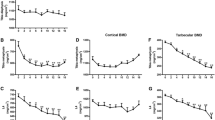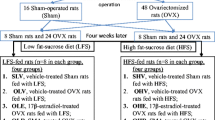Abstract
This study investigated a phytoestrogen-rich herb formula, Xianlinggubao (XLGB) μncluding genistein 510μg/g and daidzein 2500μg/g), concerning prevention of OVX-induced deterioration of musculoskeletal tissues in 11-month-old female Wistar rats, which were randomized into Sham, OVX, and XLGB groups. Daily oral administration of XLGB (250mg/kg/day) started after OVX for 3 months. mRNA of MHC-I IIa IIb of abductor muscle was determined by RT-PCR. The proximal femoral BMD and geometry, microarchitecture, and mechanical strength were evaluated by pQCT, micro-CT, and compressive testing, respectively. The bone turnover biochemical markers serum osteocalcin (OC) and urinary deoxypyridinoline (DPD) were evaluated. The results showed that (1) XLGB-treated OVX rats showed no difference compared to the Sham group, whereas OVX induced significant deterioration in variables related to bone density, microarchitecture, and mechanical strength (P < 0.05); (2) biochemical markers showed no difference between sham and XLGB groups as compared with higher bone turnover in OVX rats (P < 0.05); (3) mRNA expression of MHC-I IIa IIb was downregulated in OVX rats but upregulated after XLGB treatment (P < 0.05); and (4) as compared with the OVX group, no uterine hypertrophy was found in XLGB-treated rats. In conclusion, findings of this study suggested that the herbal preparation XLGB was able to prevent OVX-induced deterioration of musculoskeletal tissues at the hip without causing uterine stimulation.
Similar content being viewed by others
References
Lau EMC (1997) The epidermiology of osteoporosis in Asia. In: Lau EMC (ed) Osteoporosis in Asia. World Scientific, Singapore, pp 1–20
Riggs BL, Melton LJ (1995) The world-wide problem of osteoporosis: insights afforded by epidemiology. Bone 17:505–511
Nelson HD, Humphrey LL, Nygren P, Teutsch SM, Allan JD (2002) Postmenopausal hormone replacement therapy: scientific review. JAMA 288:872–881
Poirier-SolomonL (2002) HRT. Findings from the Women’s Health Initiative. Diabetes Forecast 55(12):34–36
Dambacher MA, Schmitt S, Schacht E, Ito M, Neff M, Müller R, Qin L, Zhao YL (2004) Bone structures in vitro and in vivo in animals and in men — a view into the future. J Miner Stoffwechs 2:22–28
Blake AJ, Morgan J, Bendali MJ (1998) Falls by elderly persons at home: prevalence and associated factors. Age Aging 17:365–372
Burr DB (1997) Muscle strength, bone, mass and age-related bone loss. J Bone Miner Res 12:1547–1551
Cummings SR (1995) Risk factors for hip fracture in white women. Study of Osteoporotic Fractures Research Group. N Engl J Med 332:767–773
Fisher AL (2004) Of worms and women: sarcopenia and its role in disability and mortality. J Am Geriatr Soc 52:1185–1890
NIH statement on osteoporosis prevention, diagnosis, and therapy (http://consensus.nih.gov/cons/cons.htm)
Xu L, Lu A, ZhaoX (1996) Very low rates of hip fracture in Beijing, People’s Republic of China: the Beijing Osteoporosis Project. Am J Epidemiol 144: 901–907
AdlercreutzH (2002) Phyto-oestrogens and cancer. Lancet Oncol 3: 364–373
Lien LL, Lien EJ (1996) Hormone therapy and phytoestrogens. J Clin Pharm Ther 21: 101–111
Mei J, Yeung SSC, Kung AWC (2001) High dietary phytoestrogen intake is associated with higher bone mineral density in postmenopausal but not premenopausal women. J Clin Endocrinol Metab 86: 5217–5221
Ramsey LA, Ross BS, Fischer RG (1999) Phytoestrogens and the management of menopause. Adv Nurse Practitioners 7: 26- 30
An SJ (2000) Effect of kidney-tonifying herbs on ovary function and bone mass in postmenopausal women. Chin J Osteoporosis 6: 55–59
Li H, Miyahara T, Tezuka Y, Namba T, Nemoto N, Tonami S, Seto H, Tada T, KadotaS (1998) The effect of Kampo formulae on bone resorption in vitro and in vivo. I. Active constituents of Tsu- kan-gan. Biol Pharm Bull 21: 1322–1326
Hidaka S, Okamoto Y, Nakajima K, Suekawa M, Liu SY (1997) Preventive effects of traditional Chinese (Kampo) medicines on experimental osteoporosis induced by ovariectomy in rats. Calcif Tissue Int 61: 239–246
Hidaka S, Okamoto Y, Yamada Y, Kon Y, KimuraT (1999) Japanese herbal medicine, Chujo-to, has a beneficial effect on osteoporosis in rats. Phytother Res 13: 14–19
Sakamoto S, Sassa S, Kudo H, Suzuki S, Mitamura T, ShinodaH (2000) Preventive effects of a herbal medicine on bone loss in rats treated with a GnRH agonist. Eur J Endocrinol 143: 139–142
QinL (2002) Research and development of herbal formulae for prevention and treatment of osteoporosis. International Bone Research Instructional Course and Hands-on Workshop, Hong Kong, pp 112–120
Shi YY (1998) Comparative study of four Chinese formulas on prevention of osteoporosis. Chin J Osteoporosis 4: 68–70
Shi YY (2000) Summary report on Xianlingubao capsule for treatment of osteoporosis — clinical investigations. Int J Chin Orthop 2: 18–21
Yin J, GuoL (eds) (1993) Modern Study and Clinical Applications on Chinese Materia Medica. Xue Yuan, Beijing, pp 382–652
Huang HF, You JS (1997) The use of Chinese herbal medicine on experimental fracture healing. Am J Chin Med 25: 351–356
Prestwood KM (2003) Editorial: The search for alternative therapies for menopausal women: estrogenic effects of herbs. J Clin Endocrinol Metab 88: 4075–4076
World Health Organization (1998) Regulatory situation of herbal medicines: a worldwide review. World Health Organization, Geneva
WHO Traditional Medicine Strategy 2002-2005. http://www.who. int/medicines/organization/trm/orgtrmmain.shtml
Tang JL, Leung PC (2001) An efficacy-driven approach to the research and development of traditional Chinese medicine. HK Med J 7: 375–380
Zhang G, Qin L, Shi YY, Leung KS (2004) Comparison between axial compression and lateral fall configurations: a rat proximal femur model. J Nippon Soc Bone Morphom 14: 97
Zhang G, Qin L, Hung WY, Shi YY, Leung KS (2002) Comparison of pQCT and DXA analysis for establishment of osteoporotic model in proximal femur of mature ovariectomized rats. Chin J Orthop 22: 432–436
Siu WS, Qin L, Cheung WH, Leung KS (2004) A study of trabecular bones in ovariectomized goats with micro-computed tomography and peripheral quantitative computed tomography. Bone 35: 21–26
Courtney AC, Wachtel EF, Myers ER (1995) Age related reductions in the strength of the femur tested in a fall-loading configuration. J Bone Joint Surg 77A: 387–395
Colwell A, Russell RGG, Eastell R (1993) Factors affecting the assay of urinary 3-hydroxy pyridinium crosslinks of collagen as markers of bone resorption. Eur J Clin Invest 23: 341–349
Chomczynski P (1993) A reagent for the single-step simultaneous isolation of RNA, DNA, and proteins from cell and tissue samples. Biotechnique 15: 532–537
Wright C, Haddad H(1997) Analysis of myosin heavy chain mRNA expression by RT-PCR. J Appl Physiol 83: 1389–1396
Andreassen TT, Jorgensen PH, Flyvbjerg A, Ørskov H, Oxlund H (1995) Growth hormone stimulates bone formation and strength of cortical bone in aged rats. J Bone Miner Res 10: 1057–1067
Mosekilde L, Tornvig L, Thomsen JS, Orhii PB, Banu MJ, Kalu DN (2000) Parathyroid hormone and growth hormone have additive or synergetic effect when used as intervention treatment in ovariectomized rats with established osteopenia. Bone 26: 643–651
Wang LP, Orhii PB, Banu J, Kalu DN (2001) Bone anabolic effects of separate and combined therapy with growth hormone and parathyroid hormone on femoral neck in aged ovariectomized osteopenic rats. Mech Ageing Dev 122: 89–104
Casanova M, You L, Gaido KW, Archibeque-Engle S, Janszen DB, Heck HA (1999) Developmental effects of dietary phytoestrogens in Sprague-Dawley rats and interactions of genistein and daidzein with rat estrogen receptors alpha and beta in vitro. Toxicol Sci 51: 236–244
Kuiper GGJM, Carlsson B, Grandien K (1997) Comparison of the ligand binding specificity and transcript tissue distribution of estrogen receptors α and β. Endocrmology 138: 863–870
Anderson JJ, Garner SC (1998) Phytoestrogens and bone. Baillieres Clin Endocrinol Metab 12543–557
Onoe Y, Miyaura C, Ohta H, Nozzawa S, Suda T (1997) Expression of estrogen receptor β in rat bone. Endocrinology 138: 4509–4512
Blair HC, Jordan SE, Peterson TG, Barnes S (1996) Variable effects of tyrosine kinase inhibitors on avian osteoclastic activity and reduction of bone loss in ovariectomized rats. J Cell Biochem 61: 629–637
Xu M, Dick IM, Day R, Randall D, Prince RL (2003) Effects of a herbal extract on the bone density, strength and markers of bone turnover of mature ovariectomized rats. Am J Chin Med 31: 87–101
Yu S, Chen K, Li S, Zhang K (1999) In vitro and in vivo studies of the effect of a Chinese herb medicine on osteoclastic bone resorption. Chin J Dental Res 2: 7–11
Arjmandi BH, Birnbaum RS, Juma S, Barengolts E, Kukreja SC (2000) The synthetic phytoestrogen, ipriflavone, and estrogen prevent bone loss by different mechanisms. Calcif Tissue Int 66: 61–65
Albrand G (2003) Independent predictors of all osteoporosis-related fractures in healthy postmenopausal women: the OFELY Study. Bone 32: 78–85
Jee WSS (2000) Principles in bone physiology. J Musculoskel Neuron Interact 1: 11–13
Glenmark B, Nilsson M, Gao H (2004) Difference in skeletal muscle function in males vs females; role of estrogen receptor-beta. Am J Physiol Endocrinol Metab 287: E1125-E1131
Wiik B, Glenmark M, Ekman M (2003) Oestrogen receptor β is expressed in adult human skeletal muscle both at the mRNA and protein level. Acta Physiol Scand 179: 381–387
Huang RP, Rubin CT, McLeod KJ (1999) Changes in postural muscle dynamics as a function of age. J Gerontol A Biol Sci Med Sci 54(B): 352–357
American College of Sports Medicine Position Stand (1998) Exercise and physical activity for older adults. Med Sci Sports Exer 30:992–1008
Li GP, Qin L, Chan KM (2001) Health benefits of Tai Chi Chuan in older individuals. In: Maffullii N, Chan KM, Macdonald R, Malina RM, Parker T (ed) Sports Medicine for Specific Ages and Abilities. Churchill Livingstone, Edinburgh, pp 315–324
Lipsitz LA, Nakajima I, Gagnon M (1994) Muscle strength and fall rates among residents of Japanese and American nursing homes: an international cross-cultural study. J Am Geriatr Soc 42: 953–959
Schiaffino S, Reggiani C (1996) Molecular diversity of myofibrillar proteins: gene regulation and functional significance. Physiol Rev 76: 371–423
Qin L, Shi YY, Working Group (2004) Call for establishment of general guidelines for evaluation of traditional herbal medicine developed for prevention and treatment of osteoporosis. Chin J Osteoporosis 10: 356–366
Author information
Authors and Affiliations
Corresponding author
About this article
Cite this article
Qin, L., Zhang, G., Hung, WY. et al. Phytoestrogen-rich herb formula “XLGB” prevents OVX-induced deterioration of musculoskeletal tissues at the hip in old rats. J Bone Miner Metab 23 (Suppl 1), 55–61 (2005). https://doi.org/10.1007/BF03026324
Issue Date:
DOI: https://doi.org/10.1007/BF03026324




